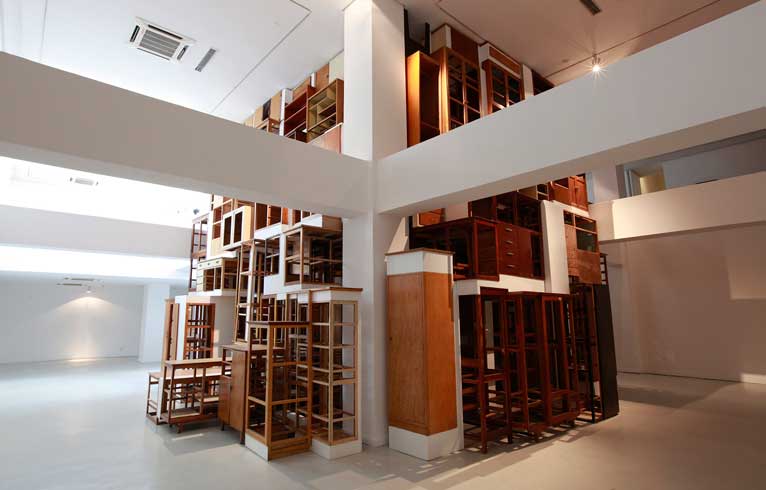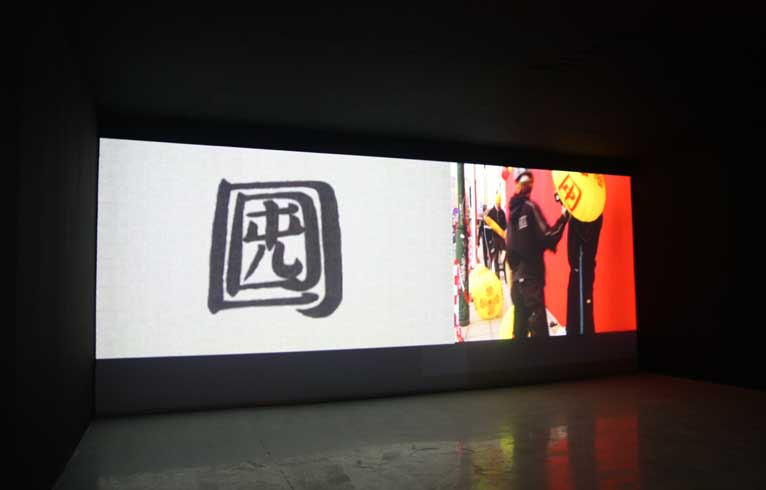MUSEUM ON PAPER: TWELVE CHINESE ARTISTS
| May 6, 2011 | Post In LEAP 8

“Twelve Chinese Artists” is an annual show featuring the 2009 “Museum on Paper” project of Contemporary Art & Investment magazine. In 2009, the monthly magazine began a column featuring in-depth introductions and discussions of the work of individual artists featured on the magazine’s cover; now, these printed projects are finally being showcased in an exhibition space. The participants come from Taiwan, Hong Kong, and the Mainland, and most are established artists active both domestically and overseas. In order to use these artists’ works to “attempt to display the complex, contemporary transformational processes of Chinese art,” the curator of the show has “approached it as a process of identity reconstruction.” So it is no wonder that these artists—aside from Pak Sheung Chuen of Hong Kong—have put a heavy emphasis on issues of ideological orientation and the artistic manifestation of political discourse.
At the entrance to the main exhibition hall is Distance, a colossal installation by Wang Jianwei. The artist assembles a tower of stacked wooden furniture, including wardrobes, cabinet, desks, and shelves in the “Socialist style” popular during the beginning of China’s period of Reform and Opening. The outward appearance of this large-scale installation work is reminiscent of the concept of “The Monument to the Third International,” the unrealized project of Russian Constructivist Vladimir Tatlin. It refracts the political implications of the unseen “Hand of God” and its behind-the-scenes role in life. To the right, on an entire wall of the main exhibition hall, hanging thermometers display the temperature in different places around the world. This is Temperature, a work by Wang Guangyi from 2010. An allusion to “political climate,” he uses a method akin to field research to expose the various ideological attitudes and positions of various countries toward global warming. However, abstract lines formed by red columns of mercury ultimately fail to provoke a reaction from the spectators.
Jiao Yingqi’s linguistic investigation of Chinese characters, The Study of Chinese Characters, and Feng Mengbo’s True Fight draw a lot of audience participation. Since the mid- 1990s, Jiao has been using the pictographic features of Chinese writing to coin new characters based on his understanding of his own life and circumstances. In The Study of Chinese Character “Guo,” he uses various methods to form characters that express the different meanings of the character guo, meaning “country” or “nation” in Chinese, and to produce new characters linked to the ideological aspects of life and culture. Visitors can participate by creating characters based on their own their own experiences. The significance of this particular character derives primarily from its role in the word zhongguo, the Chinese word for China, and not in its broader meaning of “country.” The choice of this character reveals Jiao Yingqi’s political bent. True Fight marks a continuation of Feng Mengbo’s use of video games as an art form. Visitors can control characters—the artist’s friends and acquaintances—in a fighting game. But this extremely realistic work seems to only demonstrate the appeal of games themselves.

Gao Shiqiang from the Mainland and Chen Chieh-jen from Taiwan are both video artists who focus on the circumstances of reality. Chen Chieh-jen explores Taiwan’s “internal colonization” and the political awakening of anti-establishment sentiments in ordinary people [See LEAP 7], as well as the question of the value of individual lives against the backdrop of “empire.” This exhibition features a few of his major video works: Military Court and Prison, The Route, and Factory, to name a few. These enable artistic expression to enter the political discourse of lived social realities, injecting political concepts back into the daily experiences of the Taiwanese. Forums for dialogue in various locales are used to communally explore the circumstances of ordinary people.
In contrast, Gao Shiqiang excels in using the language component of video to describe and analogize the reality of contemporary Chinese culture and society. He reveals a sensitivity to the ideological issues reflected in the phenomena of everyday life. This show features a video work titled Total Solar Eclipse. Gao takes the 2009 total solar eclipse and the financial crisis as a background and point of departure to explore the relationship between the fates of individuals and the international economic system. The eclipse, representing nature, joins people and society to form a triangular narrative framework, which Gao uses to examine the spiritual circumstances of Chinese people today. The approach is abstract but certainly perceptive, but it is impossible to know the actual depth of the spiritual impact of the financial crisis on ordinary Chinese people. I am more inclined to believe that these framing devices merely serve as metaphors for the broader state of affairs in contemporary China.
The show also includes paintings by three artists: Shu Qun’s “Order of Symbolization” series, which recalls his Rationalist landmark, the “Absolute Principle” series of 1985; Horse Market, painted by Liu Xiaodong after a visit to the town of Yanguan in Gansu Province; and four portraits by Wang Yin. Also on display are Shu Qun’s vast notes on the history of Western thought and philosophy. In comparison, Shu’s list of books he read in his youth, including the Communist Manifesto and the Book of Odes, written above Liu’s “Horse Market,” can only be considered a kind of cultural gesture. These artists’ paintings instill a fluctuating sense of time that strikes an interesting resonance with the reality of contemporary China.
For Zheng Guogu’s installation, The Sexual Mystery, the artist employed nonsensical snippets of different versions of the “Power Off Mountain” incident: the story of two Peking University students who allegedly caused a manhunt on Mt. Ling Shan after becoming separated from their classmates and turning off their mobile phones. The different versions of the episode, which went viral on the Internet, decorate eight sliding doors that open and close triggered by motion sensors. But because the vivid and rich implications of the incident itself dominate the installation’s effect, the artist’s creativity is only expressed in his selection of this particular story.
Pak Sheung Chuen’s contribution to the show is a photographic series from his Go Home Project. In this project, Pak went home with various volunteers, subtly transforming the entrance into personal space and freshly examining modern interpersonal relationships and feelings of social exchange. His photographs are quiet, small, and simple, establishing a direct and pure relationship between the art and the spectator. No extensive analysis is necessary to see that these photographs are relatively distinct from the other works in the show in terms of temperament, concept, and method of representation.
It must be mentioned that this show, as the summary of Contemporary Art & Investment’s year-long “Museum on Paper” column, does not present any new curatorial ideas. The “Chinese” label in the title seems to self-consciously assume an international staging, just as the 500,000 red lanterns that appear in one work in the show, Gu Wenda’s From China Red to China Green, display a certain kind of grand Chinese tradition, in the fashion of Beijing’s lantern-lined “Ghost Street,” for the international stage. If the idea is cultural communication and assimilation between various regions and ethnicities of different countries, then should “Western art” bring out some Christmas stockings filled with presents in exchange? For the artists involved, this sort of exhibition may exclude more individual, more representative works from their personal creative approaches. It is these more unique works that contain the artistic essence these artists seek in their explorations and thus constitute true instruments of artistic subjectivity. Identity cannot exist without subjectivity. A good show must display this kind of work to the greatest extent possible, allowing the overall structural drive of the artwork to develop the curatorial theme, and not vice-versa. Li Xiaonan

